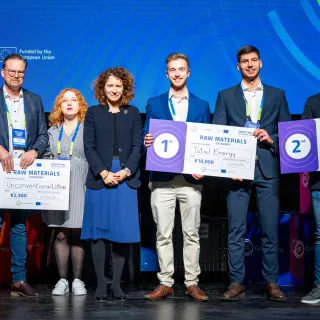EIT Innovators Award nominee builds first raw materials database of its kind
The PANORAMA database holds information on on 181 economic activities and over 2,000 products. It is the first raw materials database to reach this level of detail. The information includes the products raw materials are present in, which EU member states those products are prevalent, and the imports and exports of those raw materials.
We’re combining macro-economic data and material flow data together to try to really understand what is happening right now in EU member states. We need to know this because we need to ensure that all these transitions we are planning (i.e. the green, circular, and digital transitions) are feasible.
José Mogollon, Project Coordinator PANORMA
The ultimate vision for the raw materials database is that it will be freely available for education, research, and EU institutions to use on a not-for-profit basis. Industry will also be welcome to use the information. If they can profit from the information, there will be a feedback mechanism so that the investment in the project can be remunerated.
The Significance for 2050 Climate Neutrality Goals
José says that Europe’s ambitions to transition to a climate-neutral continent depend on accurate assessments. These assessments in turn can only be built on the type of information his raw materials database is supplying.
José explains PANORAMA’s significance for the 2050 climate goals:
We cannot simply say we are going to ramp up all the infrastructure we need for the green transition out of nothing. If we want to know if we should be opening new mines in Europe, with all of the socio-economic implications this involves, then we have to know what raw materials we need to use in the future. There is no way we can achieve the green transition without additional raw materials. Raw materials are central to the 2050 goal.
José Mogollon, Project Coordinator PANORMA
In the coming months, José will work on finalising the prototype, before focusing on pursuing avenues to make the database widely available in Europe.
The winners of the EIT Awards will be announced on 11 October at the EIT Summit in Brussels as part of INNOVEIT WEEKS.
What are the key raw materials Europe depends on for the green and digital transition? What quantities does Europe need? What raw materials can we recycle from products and use again? These are critical questions facing the European Union (EU). But is there a raw materials database where we can access the answers?
Up until now, the answer was no. The EU lacked a comprehensive, consistent, raw materials database that held information on the flows and stocks of the materials critical for the green transition.
That was until José Mogollón started the PANORAMA project, supported by EIT RawMaterials.
José is an assistant professor from the Institute of Environmental Sciences, Leiden University. He has created the first, European, raw materials database that holds physical and economic information about materials and product flows and stocks.
This critical raw materials database, currently in the prototype stage, is the reason José has been nominated by EIT RawMaterials for the EIT Innovators Award. The award recognises individuals and teams who have developed high-impact products and services.
The PANORAMA Raw Materials Database
Working with a team of three on the PANORAMA project, José created an easy-to-use, robust information system. The database encompasses all raw materials flowing through EU member states. It can be used like a search engine. Users can access and download the specific information they require.
The database supplies critical information needed by universities, research institutions, EU organisations, and industry to build towards the green and digital transition. Without this data, it would be impossible to plan for, and successfully achieve, a carbon-neutral economy by 2050.
José explains:
We need to ensure that the green and digital transition we are planning in Europe is feasible. As one example, we’re talking about the end of the internal combustion engine. What does this mean? It means we need a lot of electric vehicles. Then this means we need a lot of batteries - so then we need a lot of lithium, cobalt, and nickel. So then we have to increase the amount of raw material extraction by up to 100 fold. Can we do that for the whole of Europe? The only way to make this assessment is to know what materials are present in which products and in what quantities. This level of understanding is extremely important in the current transition we’re undergoing.José Mogollon, Project Coordinator PANORMA




